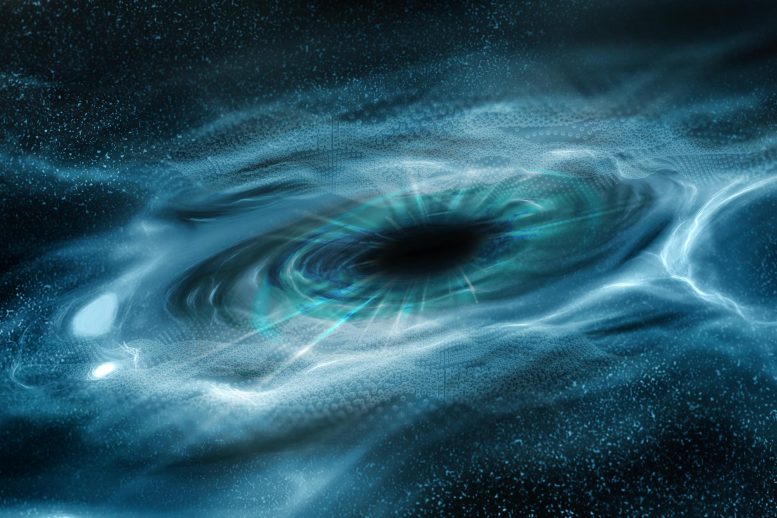
Scientists have debunked the theory that the excess high-energy radiation detected in the center of the Milky Way by the Fermi Gamma Ray Space Telescope was due to the annihilation of dark matter particles.
Exhaustive emissions modeling by global physicists narrows down particle candidates.
The detection more than a decade ago by the Fermi Gamma Ray Space Telescope of an excess of high-energy radiation in the center of the Milky Way convinced some physicists that they were seeing evidence of the annihilation of dark matter particles, but a team led by researchers at the University of California, Irvine has ruled out that interpretation.
In a paper published recently in the journal Physical Review D, the UCI scientists and colleagues at Virginia Polytechnic Institute and State University and other institutions report that – through an analysis of the Fermi data and an exhaustive series of modeling exercises – they were able to determine that the observed gamma rays could not have been produced by what are called weakly interacting massive particles, most popularly theorized as the stuff of dark matter.
By eliminating these particles, the destruction of which could generate energies of up to 300 giga-electron volts, the paper’s authors say, they have put the strongest constraints yet on dark matter properties.
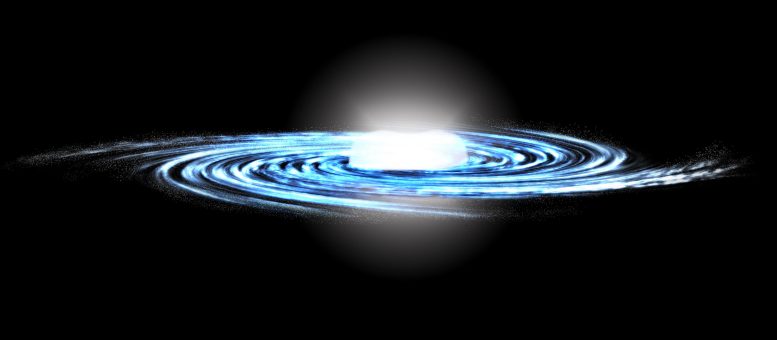
An artist’s interpretation of the Milky Way shows the “boxy” distribution of stars in the Galactic Center. A UCI-led team of physicists said in a newly published study that this shape leaves very little room for excess radiation from the destruction of dark matter particles. Credit: Oscar Macias for UCI
“For 40 years or so, the leading candidate for dark matter among particle physicists was a thermal, weakly interacting and weak-scale particle, and this result for the first time rules out that candidate up to very high-mass particles,” said co-author Kevork Abazajian, UCI professor of physics & astronomy.
“In many models, this particle ranges from 10 to 1,000 times the mass of a proton, with more massive particles being less attractive theoretically as a dark matter particle,” added co-author Manoj Kaplinghat, also a UCI professor of physics & astronomy. “In this paper, we’re eliminating dark matter candidates over the favored range, which is a huge improvement in the constraints we put on the possibilities that these are representative of dark matter.”
Abazajian said that dark matter signals could be crowded out by other astrophysical phenomena in the Galactic Center – such as star formation, cosmic ray deflection off molecular gas and, most notably, neutron stars and millisecond pulsars – as sources of excess gamma rays detected by the Fermi space telescope.
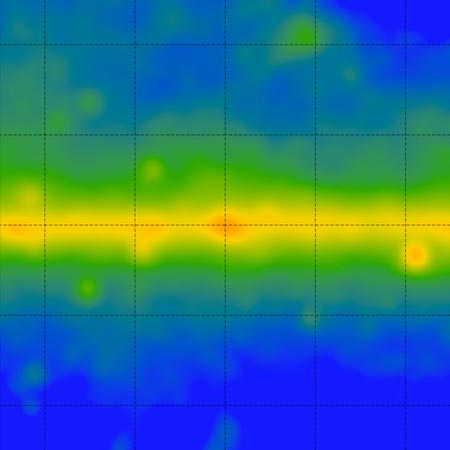
This representation of data from the Fermi Gamma Ray Space Telescope after its launch in 2008 shows an excess of high-energy radiation in the Milky Way’s Galactic Center. Many physicists attributed this to the annihilation of weakly interacting dark matter particles, but a UCI-led study has excluded this possibility through a range of particle masses. Credit: Oscar Macias for UCI
“We looked at all of the different modeling that goes on in the Galactic Center, including molecular gas, stellar emissions, and high-energy electrons that scatter low-energy photons,” said co-author Oscar Macias, a postdoctoral scholar in physics and astronomy at the Kavli Institute for the Physics and Mathematics of the Universe at the University of Tokyo whose visit to UCI in 2017 initiated this project. “We took over three years to pull all of these new, better models together and examine the emissions, finding that there is little room left for dark matter.”
Macias, who is also a postdoctoral researcher with the GRAPPA Centre at the University of Amsterdam, added that this result would not have been possible without data and software provided by the Fermi Large Area Telescope collaboration.
The group tested all classes of models used in the Galactic Center region for excess emission analyses, and its conclusions remained unchanged. “One would have to craft a diffuse emission model that leaves a big ‘hole’ in them to relax our constraints, and science doesn’t work that way,” Macias said.
Kaplinghat noted that physicists have predicted that radiation from dark matter annihilation would be represented in a neat spherical or elliptical shape emanating from the Galactic Center, but the gamma ray excess detected by the Fermi space telescope after its June 2008 deployment shows up as a triaxial, bar-like structure.
“If you peer at the Galactic Center, you see that the stars are distributed in a boxy way,” he said. “There’s a disk of stars, and right in the center, there’s a bulge that’s about 10 degrees on the sky, and it’s actually a very specific shape – sort of an asymmetric box – and this shape leaves very little room for additional dark matter.”
Does this research rule out the existence of dark matter in the galaxy? “No,” Kaplinghat said. “Our study constrains the kind of particle that dark matter could be. The multiple lines of evidence for dark matter in the galaxy are robust and unaffected by our work.”
Far from considering the team’s findings to be discouraging, Abazajian said they should encourage physicists to focus on concepts other than the most popular ones.
“There are a lot of alternative dark matter candidates out there,” he said. “The search is going to be more like a fishing expedition where you don’t already know where the fish are.”
Reference: “Strong constraints on thermal relic dark matter from Fermi-LAT observations of the Galactic Center” by Kevork N. Abazajian, Shunsaku Horiuchi, Manoj Kaplinghat, Ryan E. Keeley and Oscar Macias, 20 August 2020, Physical Review D.
DOI: 10.1103/PhysRevD.102.043012
Also contributing to this research project – which was supported by the National Science Foundation, the U.S. Department of Energy Office of Science and Japan’s World Premier International Research Center Initiative – were Ryan Keeley, who earned a Ph.D. in physics & astronomy at UCI in 2018 and is now at the Korea Astronomy and Space Science Institute, and Shunsaku Horiuchi, a former UCI postdoctoral scholar in physics & astronomy who is now an assistant professor of physics at Virginia Tech.

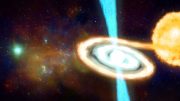

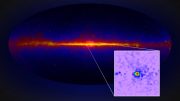
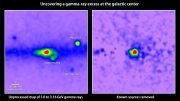


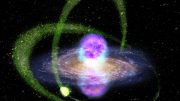
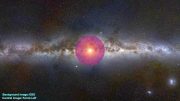
It’s a very neat work, since they both point to the baryonic – star and gas – bar as the gamma ray excess source as well as reject thermal – hot big bang generated – WIMP dark matter up to 300 GeV. ” Obtaining the correct abundance of dark matter today via thermal production requires a self-annihilation cross section of [3*10^-26 cm^3 s^-1] which is roughly what is expected for a new particle in the 100 GeV mass range that interacts via the electroweak force.” [ https://en.wikipedia.org/wiki/Weakly_interacting_massive_particles ]
As long suspected from the LHC null result, there likely isn’t any WIMP dark matter. Instead we have to look at something most likely like the known Higgs and inflation scalars, just stable and only gravitationally interacting (like inflation but stuck – stable – in the new low vacuum energy density after hot big bang). Or something else, but those models quickly get nasty…
According to NASA’s website, “It turns out that roughly 68% of the universe is dark energy. Dark matter makes up about 27%. The rest – everything on Earth, everything ever observed with all of our instruments, all normal matter – adds up to less than 5% of the universe.”
If dark energy and matter make up over 95% of the universe, why is there zero evidence for it not making up over 95% of our own solar system? Are we completely unique in the universe? Statistically, what are the odds of that? According to the theory, less than 5% of our own solar system is what we’re observing in our solar system. Yet, why don’t solar system researchers ever invoke dark matter or dark energy for explaining the dynamics and what they observe in our solar system? Or when they run into something they can’t explain, why do they never seem to ever even consider trying to explain it with dark matter or energy. Doesn’t seem to even be on their radar?
How to set the time,it is very simple create the correct time and set the alarm in your laptop set time zone windows 10 some user asked how can do i set my clock in windows 10.